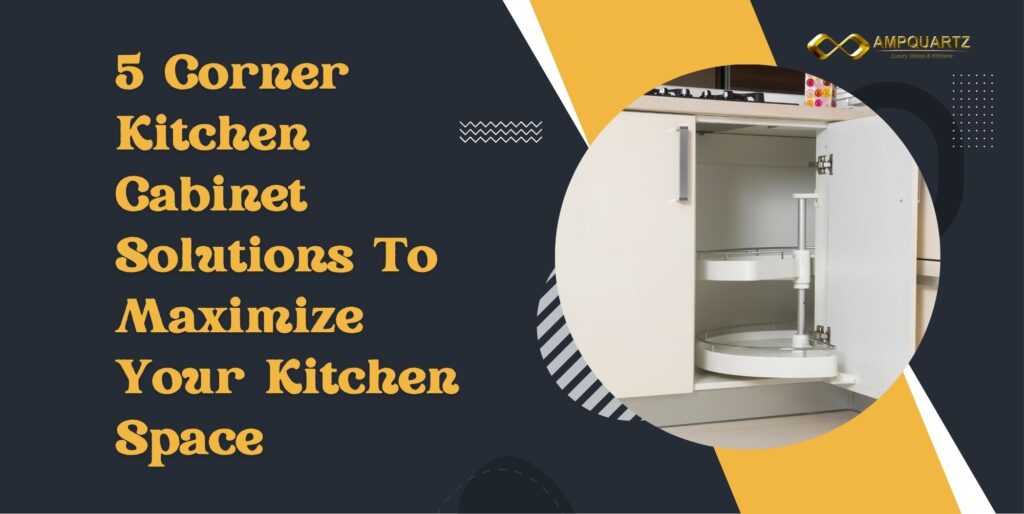Corner kitchen cabinets are often found in U-shaped or L-shaped kitchen layouts. You will be wondering what you can do with a corner kitchen cabinet. You can still store your kitchen appliances in it, but it isn't very accessible.
Corner kitchen cabinets are often called the Bermuda Triangle of the kitchen. It usually stores things that are not frequently used. You might have stored your coffee maker or juicer inside, but they may never see the light of day again as you wouldn't want to dig it out of the deep recesses of a corner kitchen cabinet.
This is totally understandable, as the angle often obstructs corner cabinet doors. It can be difficult to see inside, and not possible to grab things you want to grab. A person's comfortable reach is about two feet or below. You wouldn't want to reach deeper than that.
You can do several things to turn your corner kitchen cabinets into a beautiful and functional space. Read on, and there is definitely one solution that suits your need.
Why Are Corner Kitchen Cabinets Difficult?

Corner kitchen cabinets can be difficult, whether the base or upper cabinet. The main three reasons that make it difficult are because they are deep, dark, and inaccessible. It often happens for an L-shaped layout and a U-shaped layout. You will be reaching your items blindly when you store things inside them.
Corners kitchen cabinets can be close to 50% deeper than cabinets on either side. Usually, base cabinets will be 24 inches deep, but corner cabinets tend to be 34 inches deep. Visibility is also an issue for corner cabinets, as light is usually scarce. Adding a light to your corner cabinet may be an option. Besides, it is also hard to reach for items you want to get. You will reach the sides where it will be hard to see.
Corner Kitchen Cabinet Solutions #1 - Lazy Susan
Video Credit: Woodworker Express.com
The most classic corner kitchen cabinet solution will be the Lazy Susan. It is a simple shelve with two or three round trays attached to a rotating pole. You are able to access light items that sit on the trays easily.
There are a few choices you can choose from. One of the basic forms is the Lazy Susan sitting inside the cabinet and spinning around a fixed center. It opens on a bifold hinge. Another type will be a cheese-wheel shape with a notch that fits the door when it is closed. It won't be 100 percent space-efficient, but it won't affect too much as it will leave only a little space in the corner unused.
One more option will be integrating the door into the shelving. The entire cabinet can be opened or shut in one motion. You only need to ensure that it has a good mechanism for stopping the door in the right spot.
Corner Kitchen Cabinet Solutions #2 - Swing Out Cabinets

Swing-out cabinets is a quite common solution for corner kitchen cabinet. They are usually mounted on the cabinet door and can be installed on either the top or bottom shelf of the cabinet. When you open the cabinet door, the swing-out cabinet swings out, providing easy access to the items stored inside.
Unlike Lazy Susan, a swing-out cabinet can carry heavier objects due to its level of stability. This cabinet works with a standard door which makes it unique. Some manufacturers design this cabinet in another way: they pull away from the cabinetry instead of just pulling it out. It seems more appropriate for industrial applications. It will be a good option if you want to utilize every space of your corner kitchen cabinet.
Swing-out cabinet offers easy, unobstructed access to your kitchen appliances. You can take your things without effort. It can also be installed as an aftermarket option.
Corner Kitchen Cabinet Solutions #3 - Corner Drawers

Corner drawers are installed diagonally into the corner of the cabinet. This option is worth considering for your corner kitchen cabinet. You can pull the drawers directly out. The storage space is offered at 45-degree angles. The front lineup will be presented at 90-degree angles for a clean look.
But this option can be a large extra expense, depending on your countertop material. For example, using a butcher block or a prefab rectangular counter slab. It may also take up much of your kitchen floor space or won't fit well around an island. But if you are just planning for a basic L-shape or U-shape kitchen layout, this drawer option still comes in handy.
This option works well for storing items that fit into your corner cabinet's odd angles. It will be a good place to store cooking utensils, seasoning jars, or other small items.
Corner Kitchen Cabinet Solutions #4 - Corner Pantries
Video Credit: Fresh Design Ideas
Corner pantries are designed to make the most of the space in a corner of your kitchen. They are typically tall, narrow cabinets installed in the corner of your kitchen, providing a large amount of storage space.
Rather than installing many small drawers or pullouts, getting a full-height pantry cabinet is another option you can consider. But you want to take note that it will reduce your counter space and get plenty of room for storing dry goods.
The larger and deeper the cabinet, it will be easier to access the interior. But it will take up more floor and counter space. Depending on your need, if you have sufficient preparation space on one side or an island to use, losing some counter space wouldn't negatively affect your workflow.
Corner Kitchen Cabinet Solutions #5 - Spinout And Pullout Shelves

This option is a slight variation of the Lazy Susan concept. Instead of spinning within the cabinet, spinout shelves rotate out of the cabinet. You can access more of the shelf at once. They use the cheese-wheel shape on a central rotating mechanism. It allows the shelves to rotate out partway.
Nowadays, many modern systems allow a full extension. The entire shelf can extend out of the corner kitchen cabinet. Each shelf can move individually so that the top shelf won't cover the bottom.





